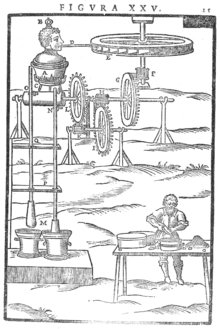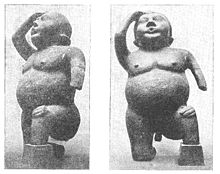Puffy

Püsteriche or Peuster , steam blowers and fire blowers ( Aeolipilae ) are hollow, usually pot-bellied male or boy figures made of clay or bronze . Antique blown oaks have been handed down as early as the second half of the 2nd century; their use may go back to before the birth of Christ.
In the 13th century, the German polymath Albertus Magnus describes a blower in his De Meteoris :
- “Take a strong ore vessel that is as vaulted on the inside as possible and has a small opening at the top and another slightly larger one on the belly, and the feet of the vessel are such that its belly does not touch the earth. It is filled with water and then firmly closed with wood at each of the two openings. You put it on a very strong fire, then steam is created in the vessel, the force of which breaks out again through one of the two closed openings. If it breaks out at the top, the water throws it widely scattered over the surrounding areas of the fire. If it breaks out from below, it splashes the water into the fire and, through the force of the steam, hurls fires, coals and hot ashes far from the fire over the surroundings. This is why such a vessel is usually called a 'sufflator' and is usually shaped like a man blowing a blow. "
With the metal figure of Philoneus presented by Keyser in his illuminated manuscript "Three dialogues between Hylas and Philonous" in 1405 , a fire blower is described:
- “I am the Philoneus and do not burn when I am empty. But hold me by the fire filled with turpentine or fiery spirit , so I spray fiery sparks with which you can light every candle. "
From the sketchbooks of Leonardo da Vinci the drawing of a steam blower as a head figure is known, which occupied the inventor around 1500.
The best-known figure is the 57 cm high, bronze " Püstrich von Sondershausen ", which probably dates from the 13th century and has been mentioned in numerous descriptions since 1591.
François Arago describes another push. According to his information, this Püstrich was found on the Weser. According to old history books, it represents the image of a Teutonic deity. She showed her displeasure with a kind of clap of thunder and a cloud that clouded the sacred grove.
Blowpipe
In Lower Germany, iron blowguns were referred to as blowpipes or blowpipes, which were mostly converted from long barrels of unusable firearms and were used in the countryside to fan the hearth. This is where the joking term "blower" for rifle or shotgun comes from. A "powder pusher" was used to powder the wigs. This probably explains the Low German name "Püster" for the Bovist , a type of mushroom that lets its spore powder escape when it is struck .
literature
- François Arago: Œuvres de François Arago . Paris, Leipzig 1854. Tome I, p. 393.
- WL Hildburgh: Aeolipiles as Fire-blowers . In: Archaeologia or Miscellaneous Tracts relating to Antiquity 94, 1951, ISSN 0261-3409 , pp. 27-56.
- Ines Jucker : The Aventicum fire blower . In: Journal for Swiss Archeology and Art History 21, 1961, Issue 2, ISSN 0044-3476 , p. 49 ff.
- Eugen von Philippovich: curiosities, antiques . Klinkhardt & Biermann, Braunschweig 1966, ( library for art and antiques lovers 46).
- Albert Schröder: The Püsterich von Sondershausen . In: The Thuringian Flag. Monthly booklets for the Central German Heimat 3, 1934, No. 7, ZDB -ID 401002-4 , picture supplement, pp. 454–455.
- Franz Maria Feldhaus : Püstriche in: The technology. An encyclopedia of prehistoric times, historical times and primitive peoples, Leipzig / Berlin 1914, column 844–850.
Individual evidence
- ↑ Krünitz, Economic Encyclopedia , Volume 119, keyword Püster .
Web links
- FM Feldhaus The history of technology of the past ... (digitized 2.4 MB; PDF)
- Püsterich in the Kunsthistorisches Museum Vienna
- Blower . In: Jacob Grimm , Wilhelm Grimm : German Dictionary . Hirzel, Leipzig 1854–1961 ( woerterbuchnetz.de , University of Trier).
